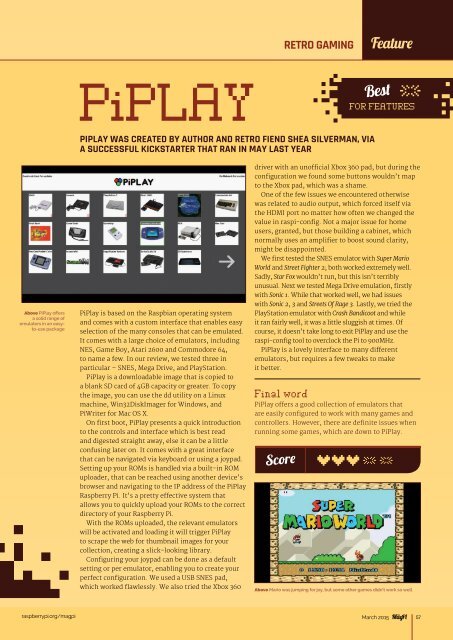Create successful ePaper yourself
Turn your PDF publications into a flip-book with our unique Google optimized e-Paper software.
RETRO GAMING<br />
Feature<br />
PiPLAY<br />
FOR FEATURES<br />
PIPLAY WAS CREATED BY AUTHOR AND RETRO FIEND SHEA SILVERMAN, VIA<br />
A SUCCESSFUL KICKSTARTER THAT RAN IN MAY LAST YEAR<br />
Best<br />
Above PiPlay offers<br />
a solid range of<br />
emulators in an easyto-use<br />
package<br />
PiPlay is based on the Raspbian operating system<br />
and comes with a custom interface that enables easy<br />
selection of the many consoles that can be emulated.<br />
It comes with a large choice of emulators, including<br />
NES, Game Boy, Atari 2600 and Commodore 64,<br />
to name a few. In our review, we tested three in<br />
particular – SNES, Mega Drive, and PlayStation.<br />
PiPlay is a downloadable image that is copied to<br />
a blank SD card of 4GB capacity or greater. To copy<br />
the image, you can use the dd utility on a Linux<br />
machine, Win32DiskImager for Windows, and<br />
PiWriter for Mac OS X.<br />
On first boot, PiPlay presents a quick introduction<br />
to the controls and interface which is best read<br />
and digested straight away, else it can be a little<br />
confusing later on. It comes with a great interface<br />
that can be navigated via keyboard or using a joypad.<br />
Setting up your ROMs is handled via a built-in ROM<br />
uploader, that can be reached using another device’s<br />
browser and navigating to the IP address of the PiPlay<br />
Raspberry Pi. It’s a pretty effective system that<br />
allows you to quickly upload your ROMs to the correct<br />
directory of your Raspberry Pi.<br />
With the ROMs uploaded, the relevant emulators<br />
will be activated and loading it will trigger PiPlay<br />
to scrape the web for thumbnail images for your<br />
collection, creating a slick-looking library.<br />
Configuring your joypad can be done as a default<br />
setting or per emulator, enabling you to create your<br />
perfect configuration. We used a USB SNES pad,<br />
which worked flawlessly. We also tried the Xbox 360<br />
driver with an unofficial Xbox 360 pad, but during the<br />
configuration we found some buttons wouldn’t map<br />
to the Xbox pad, which was a shame.<br />
One of the few issues we encountered otherwise<br />
was related to audio output, which forced itself via<br />
the HDMI port no matter how often we changed the<br />
value in raspi-config. Not a major issue for home<br />
users, granted, but those building a cabinet, which<br />
normally uses an amplifier to boost sound clarity,<br />
might be disappointed.<br />
We first tested the SNES emulator with Super Mario<br />
World and Street Fighter 2; both worked extremely well.<br />
Sadly, Star Fox wouldn’t run, but this isn’t terribly<br />
unusual. Next we tested Mega Drive emulation, firstly<br />
with Sonic 1. While that worked well, we had issues<br />
with Sonic 2, 3 and Streets Of Rage 3. Lastly, we tried the<br />
PlayStation emulator with Crash Bandicoot and while<br />
it ran fairly well, it was a little sluggish at times. Of<br />
course, it doesn’t take long to exit PiPlay and use the<br />
raspi‐config tool to overclock the Pi to 900MHz.<br />
PiPlay is a lovely interface to many different<br />
emulators, but requires a few tweaks to make<br />
it better.<br />
Final word<br />
PiPlay offers a good collection of emulators that<br />
are easily configured to work with many games and<br />
controllers. However, there are definite issues when<br />
running some games, which are down to PiPlay.<br />
Score<br />
Above Mario was jumping for joy, but some other games didn’t work so well<br />
raspberrypi.org/magpi March 2015<br />
57


